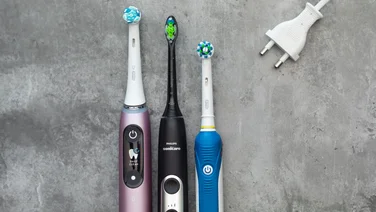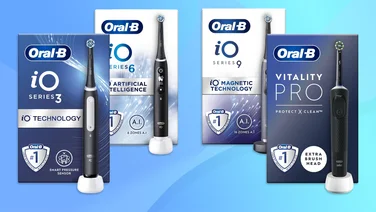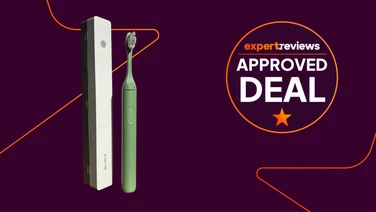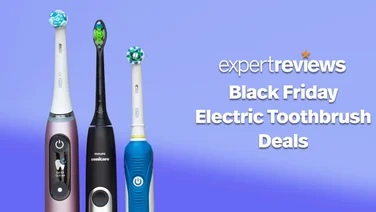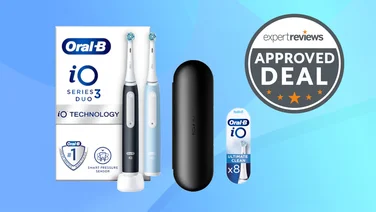To help us provide you with free impartial advice, we may earn a commission if you buy through links on our site. Learn more

If you’ve recently switched from a manual toothbrush to an electric toothbrush, you may be wondering if you should be brushing your teeth differently now. The short answer is: yes.
Around two-thirds of British adults now use an electric toothbrush, according to the Oral Health Foundation. Since most of us learn how to brush our teeth with a manual toothbrush when we’re very young, those brushing habits can stay with us when we make the switch to an electric toothbrush. And that can be bad news for your teeth.
Using an electric toothbrush like it’s a manual toothbrush, brushing with too much force, or forgetting to replace your toothbrush head regularly, these are just some of the mistakes we tend to make after the switch. And this can lead to poor cleaning, damaged tooth enamel, receding gums, or sensitive teeth.
Our guide will show you how to brush your teeth with a rotary or sonic electric toothbrush correctly for a thorough clean, from the angle of the brush, to how long you should be brushing. We’ll also take you through some of the key features you should look for, and provide you with tips on maintaining your electric toothbrush.
READ NEXT: Are electric toothbrushes better?
What are the benefits of electric toothbrushes?
Although good technique is essential whether you use electric or manual toothbrushes, the evidence stacks up in favour of electric toothbrushes. A systematic review of clinical trials in 2022 found that powered toothbrushes were far more effective than manual toothbrushes for removing dental plaque.
Electric toothbrushes also tend to improve brushing time, with electric users brushing for around ten seconds longer than manual users. And studies have found that using an electric toothbrush is more effective at combating gingivitis and protecting tooth enamel in people who have orthodontic treatment, such as braces.

Bupa Dental Care dentist, Faizan Zaheer, advises there are certain situations in which an electric toothbrush may be better than a manual brush: “An electric brush may be best if you tend to brush harshly, have limited mobility, or if your dentist has advised improving the quality of your brushing.”
There is also less plastic waste with electric toothbrushes, as you’re just replacing the head every three months, instead of a whole toothbrush.
Read Next: Best electric toothbrush
What’s the best way to use an electric toothbrush?
1. Clean twice a day, for two minutes
Dental experts recommend brushing your teeth for two minutes, twice a day, with a pea-sized blob of toothpaste that contains at least 1,350 parts per million (ppm) of fluoride.
2. Clean thoroughly, across all the teeth
The most important thing to remember is to work systematically across all the teeth, gently brushing the inside and outside surfaces. It’s a good idea to think of your teeth as divided into four quadrants, for example:
- First quadrant is the outside of your upper teeth.
- Second quadrant is the inside of your upper teeth.
- Third quadrant is the outside of your lower teeth.
- Fourth quadrant is the inside of your lower teeth.
Spending 30 seconds on each of these quadrants will ensure you don’t accidentally miss out on any spots.
Most electric toothbrushes come with quadrant pacers. These sound a beep, or insert a pause or stutter in the brushing cycle, prompting you to move to the next quadrant. If you don’t have an electric toothbrush with a quadrant pacer, try setting a timer on your phone for 30 seconds at a time.
1. Angle the brush head
Hold the brush head at a 45-degree angle to the teeth, towards the gum line. This area is a hotspot for plaque build-up – a sticky film that forms on the teeth – and failing to remove plaque effectively can lead to cavities, gingivitis, and even tooth loss.
By angling the brush in this way, you’re also reducing the risk of developing periodontal gum disease, which can also lead to tooth loss.
2. Keep it light
It’s tempting to brush hard in the mistaken belief that you’ll be cleaning away more plaque, but it won’t do your teeth any good. Brushing too hard can wear away the enamel on your teeth, leading to gum recession.
These days, many electric toothbrushes come with a pressure sensor that sounds an alarm or flashes when too much pressure is applied. Don’t ignore these warnings, and make a note of where you’re more likely to apply pressure while brushing your teeth.
3. Don’t forget the biting surfaces
Once you’ve cleaned all your quadrants, go back and clean the biting surfaces of your teeth, making sure you cover all the pits and hollows within them. You can also run the toothbrush over your tongue for a fresher feeling. Some toothbrush heads even feature a ridged panel at the back of the head for this specific purpose.
4. Don’t rinse, just spit
It’s a myth that you need to rinse out the residual toothpaste in your mouth. Simply spitting and not rinsing actually allows the fluoride in the toothpaste to protect your teeth for longer.
READ NEXT: Best water flosser
What features should I look for in an electric toothbrush?
There are effective electric toothbrushes for every budget, but the price can vary wildly. Some battery-operated toothbrushes are available for under £10, while electric toothbrushes that use artificial intelligence to improve brushing techniques can retail for over £200.
When it comes to choosing an electric toothbrush, Zaheer said, “I’d recommend looking for a model from a reputable manufacturer, rather than merely plumping for the most expensive option.
“Pricier electric toothbrushes tend to boast fancy features, such as Bluetooth connectivity to a smartphone app, but these are nice to have, rather than essential. The important thing is to choose a model that will effectively clean plaque, bacteria, and debris from your teeth and gums.”
Set your budget first, and look for a model that has some of the following features:
- Pressure sensors: A toothbrush that tells you when you’re brushing too hard will help to protect your teeth and gums more effectively. Zaheer agrees: “Brushing harder won’t remove more plaque and can, in fact, damage your teeth and irritate your gums.”
- Automatic timer: Look for a toothbrush that encourages you to brush for the full two minutes and, ideally, has quadrant pacers to help you give your teeth a thorough, whole-mouth clean.
- Battery life: If you tend to forget to charge your toothbrush, look for one with an internal lithium battery as these tend to hold their charge for longer.
- Speed: Whether you’re opting for an oscillating-rotating or a sonic brush, the higher the speed the better. Most oscillating-rotating brushes come with a speed of between 2,500 and 7,500BPM (brushes per minute), while some sonic models can operate at up to 60,000BPM.
- AI technology: Lots of electric brushes now use artificial intelligence to track brushing patterns and techniques. By downloading an app, you can check how well you’re brushing, and whether you’re covering all the surfaces you need to. However, these do tend to be much more expensive.
READ NEXT: Best Oral-B electric toothbrush
Which is better – oscillating-rotating toothbrushes or sonic toothbrushes?
Bupa dentist Zaheer says: “There’s little difference between them, however, the latest Cochrane review shows that rotating-oscillating toothbrushes outperformed the sonic option when it came to removing plaque.”
We also spoke to Dr Parneet Sehmi, a leading dentist from Hermes London Dental Clinic, for his take on whether oscillating-rotating brushes or sonic brushes are a better option.
“Sonic and oscillating-rotating toothbrushes differ in the brushing technologies, which means that determining which is better is rather a question of which is better suited to an individual’s oral health needs and preferences,” says Dr Sehmi.
“Oscillating-rotating toothbrushes have bristles which are usually arranged in a circle on a toothbrush head, which oscillates back and forth. In recent years, this technology has been incorporated with vibrating and pulsating brush head movements to remove more plaque than a single head motion, for a deeper clean.
“
[For example]
the Oral-B Pro 2 2000N is an affordable, no-nonsense electric toothbrush that performs brilliantly as the round heads provide an excellent clean. The technology also incorporates a sensitivity sensor, which will alert users if they’re brushing too hard.
“On the other hand, sonic toothbrushes similarly have rotating and oscillating features to remove plaque, but operate at faster speeds. This cleaning action reaches far beyond what a mechanical scrubbing motion can achieve. As such, the brushing covers more surface area, creating more vibrations in to and fro motions.
“Brushes such as the Phillips Sonicare ProtectiveClean are a great example of how sonic technology works to remove plaque along the gum line, and in between the teeth. Alongside that, additional technology like pressure sensors is utilised to alert users of when they are brushing too hard, or when their brush head needs to be replaced.”
In short, both brushes can give a deep and effective clean but oscillating-rotating brushes pip sonic to the post for plaque removal. Whether you opt for one over the other may just be a matter of personal preference.
How to look after your electric toothbrush
An electric toothbrush can be a big investment, so it pays to look after yours to prevent damage and keep it in good working condition.
Hard water deposits can build up over time, so Dr Sehmi advises giving your toothbrush a clean after every use. “After brushing, rinse the brush head, then detach it from the handle and clean both separately, ensuring the water runs inside the top of the handle and the brush head. Wipe all parts dry before reassembling your brush and brush head, and store it in an upright position to allow it to air dry.”
Both Dr Sehmi and Zaheer also recommend replacing the toothbrush head every three months, “as a worn toothbrush doesn’t remove plaque well.”
You may prefer to keep your electric toothbrush on its charging stand when not in use. However, some toothbrush manufacturers recommend running an electric toothbrush until it needs recharging, to prolong the life of the battery. Check your electric toothbrush’s instruction manual for details on when, and how often, to charge.
If you’re travelling with your brush, use the travel pouch that came with it, or pop it in a clean travel bag. This will protect your toothbrush and keep it clean while you’re in transit.
READ NEXT: Best teeth whitening toothpaste


